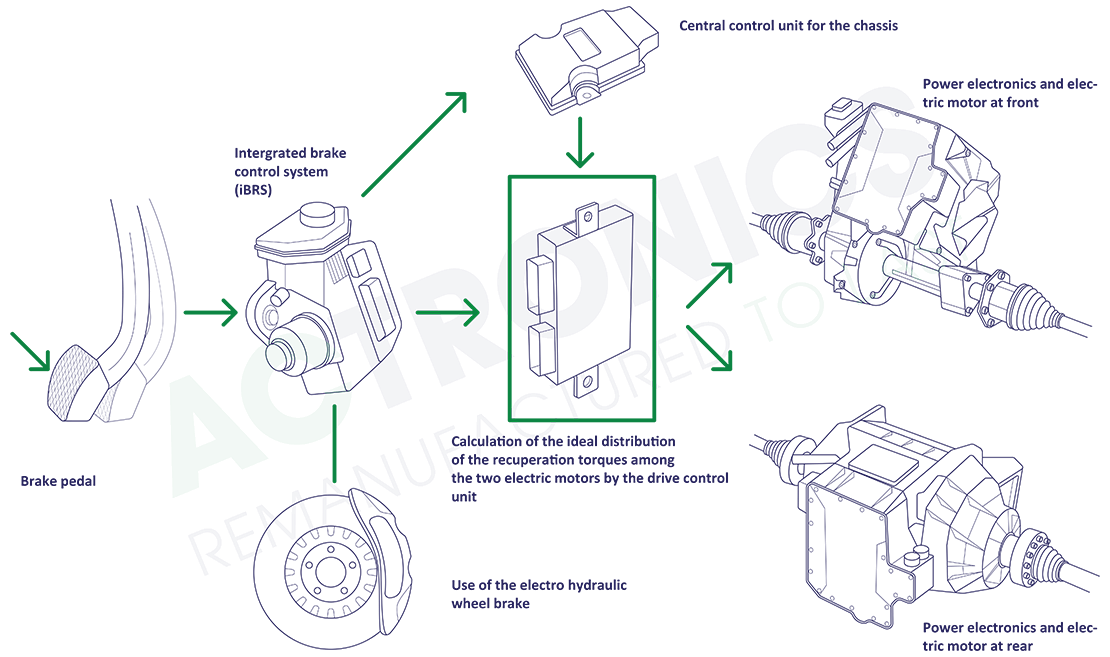How the ABS unit has evolved over the past 10 years (and what this means for the future)
The anti-lock braking system (ABS) has become a crucial (and mandatory) part of the modern car. That's not surprising because the ABS significantly improves braking performance and safety. Over the last 10 years, ABS units have undergone a significant evolution, driven by technological advancements and higher safety standards. In this article, we examine the changes and innovations in ABS units over the past 10 years and take a look at what they might look like in the future.

Photo: Schematic representation of how regenerative braking works
Evolution of ABS units over the last 10 years
Over the past 10 years, ABS units have increasingly been integrated with other safety systems, such as traction control (TCS), electronic stability control (ESC/ESP), and emergency braking assist. These integrations have significantly improved braking performance and vehicle stability. This has been made possible by high-tech sensor technology of the ABS unit. Modern ABS units use very sophisticated sensors to detect and analyze the vehicle's movements. This allows faster and more accurate response to changes while driving the car.
Another change that has contributed to the above is the improvement in the computing power of the ABS system. The control algorithms used in ABS units have become more complex and sophisticated. They can now take into account different variables, such as speed, grip, road conditions and steering input. As a result, the optimum braking force can be determined in every situation and loss of grip is minimized.
To complete the major change, ABS units have become smaller and lighter over the last 10 years. Manufacturers have adopted new materials and design techniques to reduce the size and weight of the ABS. Practical and efficient!
ABS and the near future
Now that we've looked back in time, let's take a look ahead. Because there are several developments and innovations coming up that will change the ABS in the near future. One of the most obvious is Integration with advanced braking systems for electric vehicles. With the continued growth of electric vehicles, ABS units will be more closely integrated with advanced braking systems specifically designed for electric propulsion. This includes regenerative braking, which recovers kinetic energy and converts it into electricity, and electrically controlled brake actuators that provide faster and more precise braking response. You can read about the operation of the brake booster and the ABS here.
In addition, ABS units will increasingly benefit from the continued development of connected and autonomous vehicle technologies. The ABS system will be able to exchange information with other vehicle sensors and systems, allowing them to respond even faster and more accurately to traffic situations and potentially dangerous scenarios. This will further improve the safety of the vehicle and help prevent accidents. An extension of this is an increasingly intelligent brake control. With advanced AI algorithms and machine learning, ABS units can provide intelligent braking control in the future. The system will adapt to the driver's driving style and different driving conditions. This allows for personalized braking performance that is tailored to the driver's preferences and driving style. Finally, ABS will increasingly find its way into new vehicle types. ABS units are gradually becoming commonplace in electric bicycles and scooters, for example. The demand for a safe braking system will also grow for other means of transport to prevent slipping and locking wheels.

Photo: ABS systems are also increasingly being used on e-bikes
The ABS summarized
Over the past 10 years, ABS units have undergone significant changes and innovations, such as integration with other safety systems, advanced sensor technology, improved algorithms and weight savings. In the future, ABS units will continue to evolve, with further integration into electric vehicles, connected/autonomous vehicles, intelligent braking control and expansion into new vehicle types. These developments will contribute to an even higher level of braking performance, safety and driving experience in the vehicles of tomorrow.

 da
da de
de es
es fr
fr it
it nb
nb nl
nl pt
pt sv
sv fi
fi